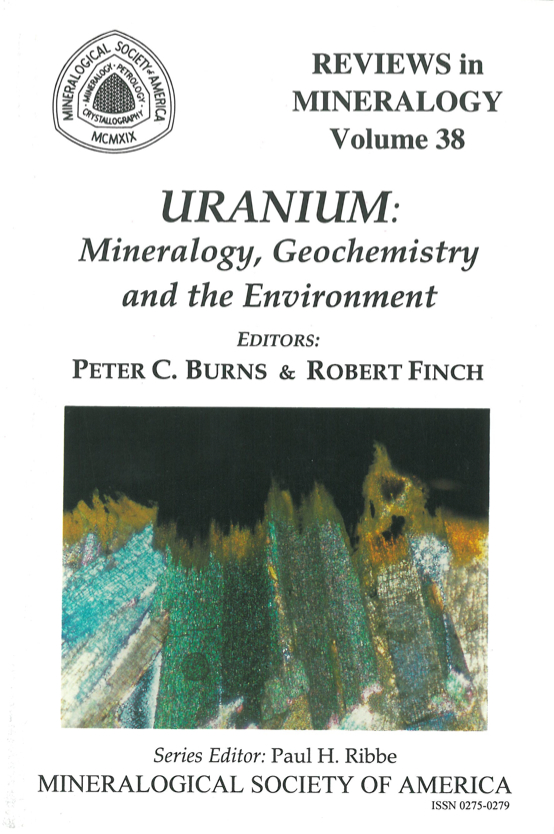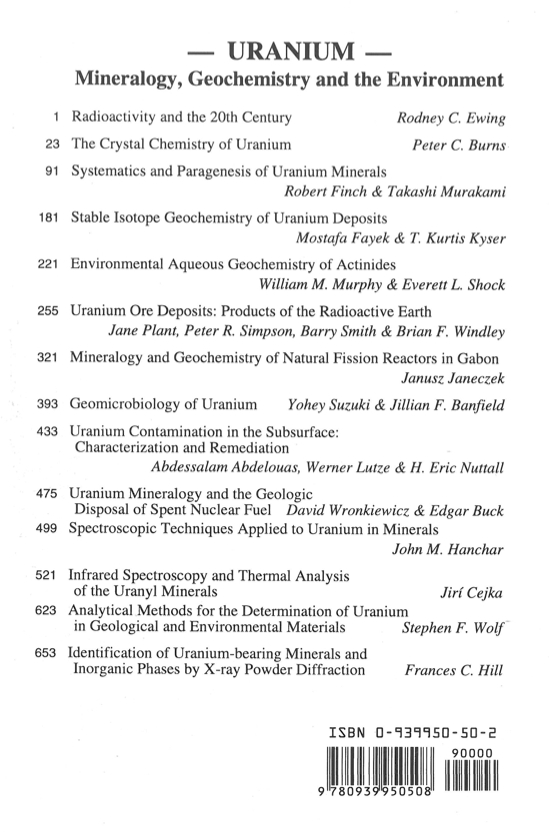

Mineralogical Society of America, Founded December 30, 1919
Order Publications Online (25% discount for MSA, CMS and GS members, except shipping)
MinPubs.org Pay-Per-View GeoScienceWorld Pay-Per-View


1999 i-xvi + 679 pages. ISBN 0-939950-50-2; ISBN13 78-0-939950-50-8
This volume was written in preparation for a short course by the same title, sponsored by the Mineralogical Society of America, October 22 and 23, 1999 in Golden, Colorado, prior to MSA's joint annual meeting with the Geological Society of America.
Research emphasis in traditional mineralogy has often focused on detailed studies of a few hundred common rock-forming minerals. However, scanning the contents of a current issue of American Mineralogist or Canadian Mineralogist, or the titles of recent Reviews in Mineralogy volumes reveals that the emphasis of mineralogical research has undergone considerable change recently. Less-common, low-temperature minerals are receiving ever increasing attention, often owing to their importance to the environment. A tremendous challenge lies ahead for mineralogists and geochemists: the occurrences, structures, stabilities, and paragenesis of perhaps a thousand low-temperature minerals require detailed study if geoscientists are to be properly equipped to tackle environmental problems today and in the future. In many low-temperature environments mineral assemblages are extremely complex, with more than 10 species common in many em-size samples. This Reviews in Mineralogy volume provides detailed reviews of various aspects of the mineralogy and geochemistry of uranium; hopefully the reader will benefit from this presentation, and perhaps more importantly, the reader may develop a sense of the tremendous amount of work that remains to be done, not only concerning uranium in natural systems, but for low-temperature mineralogy and geochemistry in general.
The low crustal abundance of uranium belies its mineralogical and geochemical significance: more than five percent of minerals known today contain uranium as an essential constituent. Uranium is a geochemical and geochronological indicator, and the U-Pb decay series has long been one of the most important systems for dating rocks and minerals. Uranium is an important energy source, and the uranium nuclear fuel cycle has generated a great deal of interest in uranium mineralogy and geochemistry since the first controlled nuclear fission reaction nearly sixty years ago. Current interest in uranium mineralogy and geochemistry stems in large part from the utilization of uranium as a natural resource. Environmental issues such as coping with uranium mine and mill tailings and other uranium-contaminated sites, as well as permanent disposal of highly radioactive uranium-based nuclear fuels in deep geologic repositories, have all refocused attention on uranium.
More than twenty years have passed since the 1978 Mineralogical Association of Canada's Short Course on Uranium Deposits. A realignment of research focus has clearly occurred since then, from exploration and exploitation to environmental remediation and geological "forecasting" of potential future impacts of decisions made today. The past decades have produced numerous remarkable advances in our understanding of uranium mineralogy and geochemistry, as well as technological and theoretical advances in analytical techniques which have revolutionized research of trace-elements, including uranium. It was these advances that provided us the impetus to develop this volume.
We have attempted to produce a volume that incorporates most important aspects of uranium in natural systems, while providing some insight into important applications of uranium mineralogy and geochemistry to environmental problems. The result is a blend of perspectives and themes: historical (Chapter 1), crystal structures (Chapter 2), systematic mineralogy and paragenesis (Chapters 3 and 7), the genesis of uranium ore deposits (Chapters 4 and 6), the geochemical behavior of uranium and other actinides in natural fluids (Chapter 5), environmental aspects of uranium such as microbial effects, groundwater contamination and disposal of nuclear waste (Chapters 8, 9 and 10), and various analytical techniques applied to uranium-bearing phases (Chapters 11-14).
Peter C. Burns, Notre Dame, Indiana, USA
Robert J. Finch, Argonne, Illinois, USA
August 26, 1999
Title Page
p. i
Copyright
p. ii
Foreword & Preface
p. iii - iv
List of Titles & Authors
p. v - vi
Table of Contents
p. vi - xvi
Chapter 1. Radioactivity and the 20th Century
by Rodney C. Ewing, p. 1 - 22
Chapter 2. The Crystal Chemistry of Uranium
by Peter C. Burns, p. 23 - 90
Replacement for Page 64 (pdf format)
Chapter 3. Systematics and Paragenesis of Uranium Minerals
by Robert Finch and Takaski Murakami, p. 91 - 180
Chapter 4. Stable Isotope Geochemistry of Uranium Deposits
by Mostafa Fayek and T. Kurtis Kyser, p. 181 - 220
Chapter 5. Environmental Aqueous Geochemistry of Actinides
by William M. Murphy and Everett. L. Shock, p. 221 - 254
Chapter 6. Uranium Ore Deposits: Products of the Radioactive Earth
by Jane Plant, Peter R. Simpson, Barry Smith, and Brian F. Windley, p. 255 - 320
Chapter 7. Mineralogy and Geochemistry of Natural Fission Reactors in Gabon
by Janusz Janeczek, p. 321 - 392
Chapter 8. Geomicrobiology of Uranium
by Yohey Suzuki and Jillian F. Banfield, p. 393 - 432
Chapter 9. Uranium Contamination in the Subsurface: Characterization and Remediation
by Abdessalam Abdelouas, Werner Lutze, and H. Eric Nuttall, p. 433 - 474
Chapter 10. Uranium Mineralogy and the Geologic Disposal of Spent Nuclear Fuel
by David Wronkiewicz and Edgar Buck, p. 475 - 498
Chapter 11. Spectroscopic Techniques Applied to Uranium in Minerals
by John M. Hanchar, p. 499 - 520
Chapter 12. Infrared Spectroscopy and Thermal Analysis of the Uranyl Minerals
by Jiri Cejka, p. 521- 622
Errata for Chapter 12 (pdf format)
Chapter 13. Analytical Methods for the Determination of Uranium in Geological and Environmental Materials
by Stephen F. Wolf, p. 623 - 652
Chapter 14. Identification of Uranium-bearing Minerals and Inorganic Phases by X-ray Powder Diffraction
by Frances C. Hill , p. 653 - 680